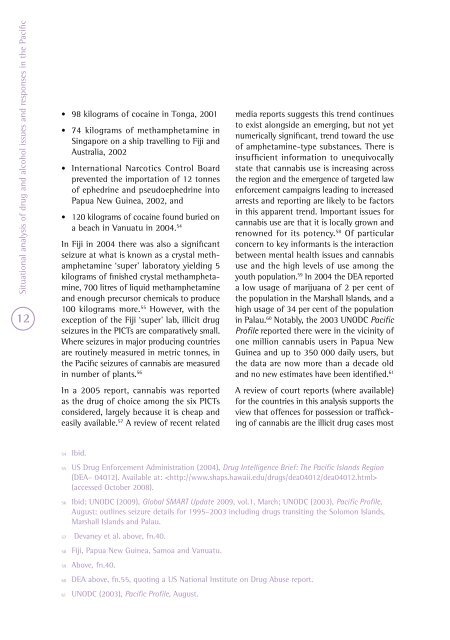rp21 situational analysis - Pacific Health Voices
rp21 situational analysis - Pacific Health Voices
rp21 situational analysis - Pacific Health Voices
Create successful ePaper yourself
Turn your PDF publications into a flip-book with our unique Google optimized e-Paper software.
Situational <strong>analysis</strong> of drug and alcohol issues and responses in the <strong>Pacific</strong><br />
12<br />
• 98 kilograms of cocaine in Tonga, 2001<br />
• 74 kilograms of methamphetamine in<br />
Singapore on a ship travelling to Fiji and<br />
Australia, 2002<br />
• International Narcotics Control Board<br />
prevented the importation of 12 tonnes<br />
of ephedrine and pseudoephedrine into<br />
Papua New Guinea, 2002, and<br />
• 120 kilograms of cocaine found buried on<br />
a beach in Vanuatu in 2004. 54<br />
In Fiji in 2004 there was also a significant<br />
seizure at what is known as a crystal methamphetamine<br />
‘super’ laboratory yielding 5<br />
kilograms of finished crystal methamphetamine,<br />
700 litres of liquid methamphetamine<br />
and enough precursor chemicals to produce<br />
100 kilograms more. 55 However, with the<br />
exception of the Fiji ‘super’ lab, illicit drug<br />
seizures in the PICTs are comparatively small.<br />
Where seizures in major producing countries<br />
are routinely measured in metric tonnes, in<br />
the <strong>Pacific</strong> seizures of cannabis are measured<br />
in number of plants. 56<br />
In a 2005 report, cannabis was reported<br />
as the drug of choice among the six PICTs<br />
considered, largely because it is cheap and<br />
easily available. 57 A review of recent related<br />
media reports suggests this trend continues<br />
to exist alongside an emerging, but not yet<br />
numerically significant, trend toward the use<br />
of amphetamine-type substances. There is<br />
insufficient information to unequivocally<br />
state that cannabis use is increasing across<br />
the region and the emergence of targeted law<br />
enforcement campaigns leading to increased<br />
arrests and reporting are likely to be factors<br />
in this apparent trend. Important issues for<br />
cannabis use are that it is locally grown and<br />
renowned for its potency. 58 Of particular<br />
concern to key informants is the interaction<br />
between mental health issues and cannabis<br />
use and the high levels of use among the<br />
youth population. 59 In 2004 the DEA reported<br />
a low usage of marijuana of 2 per cent of<br />
the population in the Marshall Islands, and a<br />
high usage of 34 per cent of the population<br />
in Palau. 60 Notably, the 2003 UNODC <strong>Pacific</strong><br />
Profile reported there were in the vicinity of<br />
one million cannabis users in Papua New<br />
Guinea and up to 350 000 daily users, but<br />
the data are now more than a decade old<br />
and no new estimates have been identified. 61<br />
A review of court reports (where available)<br />
for the countries in this <strong>analysis</strong> supports the<br />
view that offences for possession or trafficking<br />
of cannabis are the illicit drug cases most<br />
54 Ibid.<br />
55 US Drug Enforcement Administration (2004), Drug Intelligence Brief: The <strong>Pacific</strong> Islands Region<br />
(DEA– 04012). Available at: <br />
(accessed October 2008).<br />
56 Ibid; UNODC (2009), Global SMART Update 2009, vol.1, March; UNODC (2003), <strong>Pacific</strong> Profile,<br />
August: outlines seizure details for 1995–2003 including drugs transiting the Solomon Islands,<br />
Marshall Islands and Palau.<br />
57 Devaney et al. above, fn.40.<br />
58 Fiji, Papua New Guinea, Samoa and Vanuatu.<br />
59 Above, fn.40.<br />
60 DEA above, fn.55, quoting a US National Institute on Drug Abuse report.<br />
61 UNODC (2003), <strong>Pacific</strong> Profile, August.
















